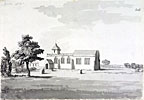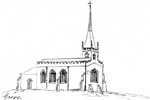 Grove Grove
St Helen
History
A church and priest at Grove are recorded in Domesday Book, alongside eight acres of meadow and woodland pasture. During the eleventh and twelfth centuries, Grove was a double rectory and also a vicarage of medieties (i.e. a vicarage shared between more than one priest), but on 3 May 1227, George de Ordsall, who was vicar of one mediety, was presented to the entire vicarage by Malvesinus de Hercy on condition that he should allow the rector 28s. annually and in perpetuity. This was later reduced to one mark (13s. 4d.), when William Maulovel was instituted to the rectory on 9 March 1232 upon presentation by William Refus.
On 14 July 1303, Thomas of Corbridge, archbishop of York, directed the dean of Retford to allow Robert de Wolrington, upon giving security for four marks, to the fruits of this church during the coming autumn.
In 1313 the rector of Grove, John de Corbridge, was in serious trouble. His goods were sequestered following a royal writ and were put into the house belonging to the church ('mansum') because he owed Hugh of Lambley 48 or 49s. The dean of Retford was instructed both to execute the royal writ and recover the money, and to issue a sentence of excommunication against Corbridge, which archbishop Greenfield had imposed.
In 1339, a legal dispute broke out over the advowson of the vicarage, and it was settled in favour of Hugh de Hercy, lord of Grove and his heirs. Another dispute over the advowson occurred in 1366 was again settled in favour of the Hercy family.
In a series of wills surviving at York, the church at Grove sometimes appears as Grove St Helen, and in others it is dedicated to the Invocation to the Holy Cross. It appears that Grove actually carried a double-dedication, and such is recorded in 1291 on the ecclesiastical taxation assessment of Pope Nicholas IV, where the church appears as Grove St Helen and Invocation to the Holy Cross. In 1291, Grove was valued at £6 13s. 4d., whilst in 1428 the church was valued at 10 marks, paying a subsidy of 13s. 4d. to Henry VI, showing that there had been no change in value during the intervening period since 1291.
Records survive for a couple of legal cases in the middle ages involving the parson of Grove. In 1333, Thomas de Scardeborough, parson of Grove, acknowledged a debt of £16 to Thomas de Hercy, parson of Wintringham (North Yorkshire), with the sum to be levied in default of payment on his lands, chattels, and ecclesiastical goods in Nottinghamshire. Meanwhile, Richard Belle, parson of Croft, was outlawed for a trespass committed against Thomas de Amcotes, parson of Grove in 1359. During the sixteenth century, Grove St Helen received a number of benefactions from local notables, the Hercy family. Hugh Hercy Esq, whose will was proved 9 April 1457, desired burial in St Helen’s church. He left 3s. 4d. for the church fabric, 6s. 8d. for his obits, and his best horse to the rector. Humphrey Hercy Esq., who died in 1511, desired burial in the choir or chancel here and left a mortuary of 40d. ‘after the laudable custom of the church’, and to the high altar for tithes forgotten. His son, Humphrey, d. 1520, also willed to be buried in the chancel.
In 1587 the churchwardens reported that the chancel was in decay, but provided no further details. By 1608 the chancel was still 'out of repair in the default of Francis Nevell, parson'. However by 1618 all was well as the churchwardens presented that: 'our church is in good repair and has all things according to our articles, except a Homily book, which will be had before the next visitation; divine service is duly performed and all other things in good order and form'.
A full account of the church and parish is provided by the visitation return of Robert Wright, rector of Grove, to Archbishop Herring in 1743. There were 22 families in the parish, none of whom were dissenters. There was no meeting house, nor any public or charity school, although there were two almshouses. No lands or tenements had been left for the repair of the church or for any other pious use. The rector at the time resided in the parsonage house within the parish, and was not aided by a curate. Nobody in the parish was not baptised, and the rector knew of nobody who, being of sufficient age, had not been confirmed. The public service was performed twice every Lord’s Day, and the rector noted that he began to catechise shortly before Lent and ended on Trinity Sunday. The sacrament and the Lord’s Supper were administered on Palm Sunday and Easter Day, on Whitsunday, at Michaelmas, and on Christmas Day. There were 52 communicants in the parish, and at the previous Easter 26 had received the sacrament. The exhortation was read on the Sunday preceding every sacrament, which the rector had never refused to anyone. Robert Wright had instituted on 18 June 1737, and the churchwardens at the time of the visitation return were Thomas Butler and John Webster.
In 1764 the rector was William Pashley. Information collected for Archbishop Drummond’s Visitation showed that there were thirteen families in the parish and ‘a hospital containing two poor persons’. None were dissenters. Pashley lived in the parsonage and conducted two services ‘every Sunday, with a sermon in the morning, except only at such times as ill health or gratuitous assistance given to the clergy my neighbours oblige me to neglect it in part’. He administered Holy Communion five times a year.
In 1761 the rector, William Pashley, took issue with the churchwardens, George Poole and John Barthrop, that 'the roof timbers are very decayed and in such a bad state that the parishioners dare not assemble beneath it' even though the wardens had certified that they had been repaired and a certificate of good repair of the roof was signed by John Simpson of Thoresby and Robert Bargh of Worksop, carpenters, on 4 Aug 1761. A further inspection took place by Ignatious Stanley of Holbeck Woodhouse and Robert Bargh of Worksop, carpenters, on 6 Nov 1761 and they found it to be in good repair, certified 9 Dec 1761, and witnessed by George Morton and Charles Harrington. Notwithstanding this, Pashley issued cause papers on 20 Jan 1762.
 Grove church in 1773. Grove church in 1773. |
Writing in the 1790s, John Throsby noted that the small church, dedicated to St Helen, consisted of a nave and chancel, with a low tower and two bells. An old monumental stone was observed on the chancel floor; an alabaster slab 6.5 feet long, 3 feet 3 inches broad. The inscription reveals that this was the commemorative slab of Hugh Hercy Esq., who is buried in the chancel. Throsby also remarked that the parsonage house was ‘seated pleasantly’, having been ‘greatly improved by the liberal taste of the present possessor’.
The Retford historian, John Shadrach Piercy, described the church in the 1820s as follows:
'The situation of this church is peculiarly pleasing and interesting; seated on an eminence, and surrounded by trees rendered venerable from their great age ... The church is small and ancient; it is dedicated to St. Helen, and consists of a nave and chancel; in its exterior it has nothing whereof to boast, its interior is simple, clean, and in good repair. The tower is squat and contains two bells.'
The religious census of 1851 recorded that Grove parish covered an area of 1,287 acres and included a total population of 92 parishioners. There was space for 100 parishioners in the church, 22 of which were free. The general congregation in the morning was usually attended by 35 parishioners, whilst around 45 attended in the afternoon. There were 20 children enrolled in Sunday School, 10 attending in the morning and 10 in the evening. The living at this time was valued at £11 14s. 2d., whilst the tithes had been commuted for £144.
 Grove church in the Grove church in the
early-mid 19th century. |
Sir William Glynne visited Grove twice, in 1841 and 1860, and provides a detailed architectural description:
'A small church, having only nave and Chancel and a brick turret over the W. end surmounted by a mean slated Spire. The nave is Perpendr – and embatiled has one each side windows of 3 lights closely set – much like those at Headon – with merely foliated lights [Headon was visited on the same day in 1860]. The Chancel arch is on octagonal shafts. The Chancel seems to have been rebuilt in a poor debased style and has squareheaded windows of 3 and 4 lights. The Font is an ordinary one of octagonal form. The Interior is very bald and glaring – with high pues – but the churchyard is pretty and secluded.'
The church subsequently became 'so ruinous as to be no longer proof against the weather and the rain found ready ingress' which was a 'great discomfort to both clergy and people.' Rather than restore the church the rector, the Rev Evelyn Hardolph Harcourt Vernon, decided to build a new one and commissioned the Durham architect, Charles Hodgson Fowler. The site of the new church was a short distance to the north and services continued to take place in the old building until the new church was consecrated by the Bishop of Lincoln on 6 December 1882. The cost of its construction (over £4,000) was entirely met by the rector.
 The 1882 church c.1905 The 1882 church c.1905 |
The new church consists of a nave, chancel, north transept, south porch, a vestry on the north side of the chancel, and a tower with two bells and a clock surmounted by a spire. The style has been described as a variation of ‘Late Decorated’. The lower storey of the tower is vaulted and forms the baptistry containing the font and also the commemorative slabs of the Hercy family which were transferred from the old church.
On 4 May 1882 'an extraordinary circumstance' took place when Scottish Police Sergeant Gilmour, accompanied by Inspector Earp of Retford, arrived on site to arrest David Andrews, foreman of the works. Andrews had been involved in the building of a school at Pollockshields in Glasgow. Tragically part of the school, a timber play shed, had collapsed in March killing four children and injuring nine others. On 21 June 1882 Andrews and four others found themselves before Lord Young at the Glasgow Circuit Court charged with culpable homicide. After listening to the evidence the judge dismissed the charges.
A faculty 'to take down the old church' was granted by the Diocese of Lincoln on 19 December 1882. The intention was to use some of the materials to build a wall around the churchyard, replacing the temporary wooden fence.
Grove St Helen was visited on 23 June 1914 at 4.00 p.m. by Edwyn Hoskyns, Bishop of Southwell, for the purposes of a parochial visitation. The rector at this time was A. K. Moore, and the parish was valued at £126. The population of the parish was 148, and the church could accommodate 120 parishioners. There were 26 children enrolled in Sunday School, whilst 33 were enrolled in church day school.
In 1949, a parish meeting was held to discuss the prospects of making the roof watertight. At the same meeting, plans for dislodging jackdaws from the church tower, and cleansing it were also made.
The church registers date from 1726.
| 


 Grove church in 1773.
Grove church in 1773. Grove church in the
Grove church in the The 1882 church c.1905
The 1882 church c.1905





